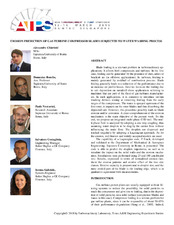| dc.description.abstract | Blade fouling is a relevant problem in turbomachinery applications.
It affects both compressors and turbines. In the first
case, fouling can be generated by the presence of dust, ashes or
brackish air (in offshore applications). In turbines, fouling is
mainly generated by residual of combustion process. Blade
fouling generally leads to a reduction of the performance due to
an increase on profile losses. Here we focus on the fouling due
to salt deposition on naval/off-shore applications referring to
machines that are part of the fleet of gas turbines manufacturers.
In such applications, it is common to introduce on-line
washing devices aiming at removing fouling from the early
stages of the compressors. The water is sprayed upstream of the
first rotor, it impacts on the rotor blades and thus dissolving the
deposited salt. However, this procedure possibly leads to blade
erosion and/or corrosion. A clear comprehension of the erosion
mechanism is the main objective of the present work. To this
end, we propose an integrated multi-phase CFD tool. The multi-phase
flow is analyzed by adopting a one-way coupling, thus
assuming water droplets to be drag by the carrier flow without
influencing the main flow. The droplets are dispersed and
tracked singularly by adopting a Lagrangian approach. As for
the erosion, well-known and widely accepted models are used.
The capability of a Lagrangian code, P-Track, developed
and validated at the Department of Mechanical & Aerospace
Engineering, Sapienza University in Rome, is presented. The
code is able to predict the droplets trajectories, as well as to
simulate the impact on the solid walls and the erosion mechanism.
Simulations were performed using 25 and 100 ?m droplet
size. Results, expressed in terms of normalized erosion rate,
show the erosion patterns and erosive effect of the two size
classes. Erosive capacity is proportional to droplet size, and the
most eroded part of the blade is the leading edge, which is in
qualitative agreement with measurements. | en |


